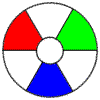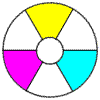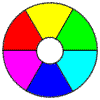The Primary Colors of Light
These are different from
primary colors in art. If you need to know red, blue, and yellow are color
primary colors. Go to this color worm address below and you'll find a
great coloring book to explain this to your students. It's free and
downloadable. Thank you Laurie, for pointing this out to me!



 The
primary colors of light are red, green, and
blue.
The
primary colors of light are red, green, and
blue.
Red, blue, and green
are the primary colors of light. Mixing these colors can produce all of the
colors of the spectrum.
 The
Complementary Colors
The
Complementary Colors



The complementary colors are cyan,
magenta, and yellow which
are formed by combining the two adjacent primary colors. Red and
blue make magenta, blue and green make cyan, and
red and green make yellow.
 The
Color Wheel
The
Color Wheel


 The
primary and complementary colors combine to make the Color
Wheel. Clockwise from the top the colors are: yellow,
green, cyan, blue,
magenta and red. On the Color Wheel, harmonizing
colors are adjacent. Contrasting
colors are separated by another color. Red and green are contracting colors.
Colors that clash are opposite on the
wheel - green and magenta for example.
The
primary and complementary colors combine to make the Color
Wheel. Clockwise from the top the colors are: yellow,
green, cyan, blue,
magenta and red. On the Color Wheel, harmonizing
colors are adjacent. Contrasting
colors are separated by another color. Red and green are contracting colors.
Colors that clash are opposite on the
wheel - green and magenta for example.
 The hue
is the basic color that distinguishes one color from another - blue from
red for
example.
The hue
is the basic color that distinguishes one color from another - blue from
red for
example.
 Saturation
is the purity of hue. A saturated blue, for example, is composed only of pure
blue color. Hues can become desaturated by the
addition of either black (shadow) or white (light). Adding light makes the color
more pale, producing a tint. Adding black, by covering the color with a
shadow, gives a shade. In the diagram
below the center wheel has pure fully saturated color. As you move to the left
black is added to produce shades. As you move to the right white is added to
produce tints.
Saturation
is the purity of hue. A saturated blue, for example, is composed only of pure
blue color. Hues can become desaturated by the
addition of either black (shadow) or white (light). Adding light makes the color
more pale, producing a tint. Adding black, by covering the color with a
shadow, gives a shade. In the diagram
below the center wheel has pure fully saturated color. As you move to the left
black is added to produce shades. As you move to the right white is added to
produce tints.









 The
luminance of a color is the characteristic we describe when we
say a color is light or dark. A bright color seems to
reflect more light than a dark one.
The
luminance of a color is the characteristic we describe when we
say a color is light or dark. A bright color seems to
reflect more light than a dark one.












